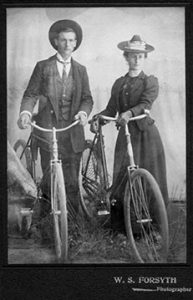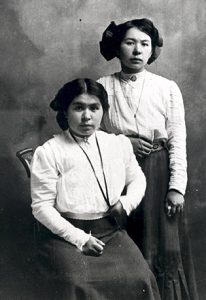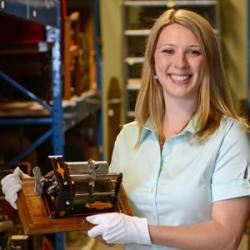
Formal portrait of Fred and Annie Thornton by William Forsyth inside his Wellington Avenue studio, ca. 1900.
Chilliwack Museum and Archives P81
Photography has long attempted to discover its own aesthetic language, formed by the camera’s limitations and released by photography’s technological development: from the first formal and stylized photographs, via Kodak’s revolution and its democratic experimentation, forward to present-day pictures that can be said to mirror the entire aesthetic development.
In portraiture, the correlation between ‘reality’ and ‘likeness’ as perceived within the format of the photograph is undeniable. This combination of illusion and real life, guarantees its continuing success as a medium for this purpose, whether digital, moving or other lens-based methods of making portraits.
At first photography was either used as an aid in the work of an artist or followed the same principles the artists followed. The first publicly recognized portraits were usually portraits of either one person or family portraits to preserve the memories.
Early photographic portraits relied heavily on the conventions of the painted portrait. Victorian artists commonly used pillars and swathes of drapery to enhance the backgrounds of their photographs. In addition to these traditional backdrops, appropriate symbols of wealth or signs of the person’s occupation would be included. For example, this William Forsyth portrait of Fred and Annie Thornton, ca. 1900, shows the couple posing with their new bicycles, a substantial symbol of wealth at the turn of the previous century. The photographer even placed ground covering on the floor of his studio to create the illusion of being outdoors.
Why didn’t they smile in photographs?

Formal studio portrait of Josephine (left, seated) and Susan (right, standing) Cooper of the Soowahlie First Nation, near Cultus Lake, ca. 1910. Chilliwack Museum and Archives P5598.
If you look very long at unsmiling old photos you will see the answer: that they are freezing their faces in order to keep still for the long exposure times.
People who posed for early photographs understood it as a significant moment. Photography was still rare. For many people it might be a once-in-a-lifetime experience. Posing for the camera did not seem that different from having your portrait painted. It was cheaper, quicker and meant that people who never had a chance to be painted could now be portrayed.
Like a portrait painting, it was intended as a timeless record of a person.
We look to sharing the development of photographic aesthetics with you at our upcoming exhibit, Photography from Obscura to App, opening September 23, 2016.


Comments are closed.